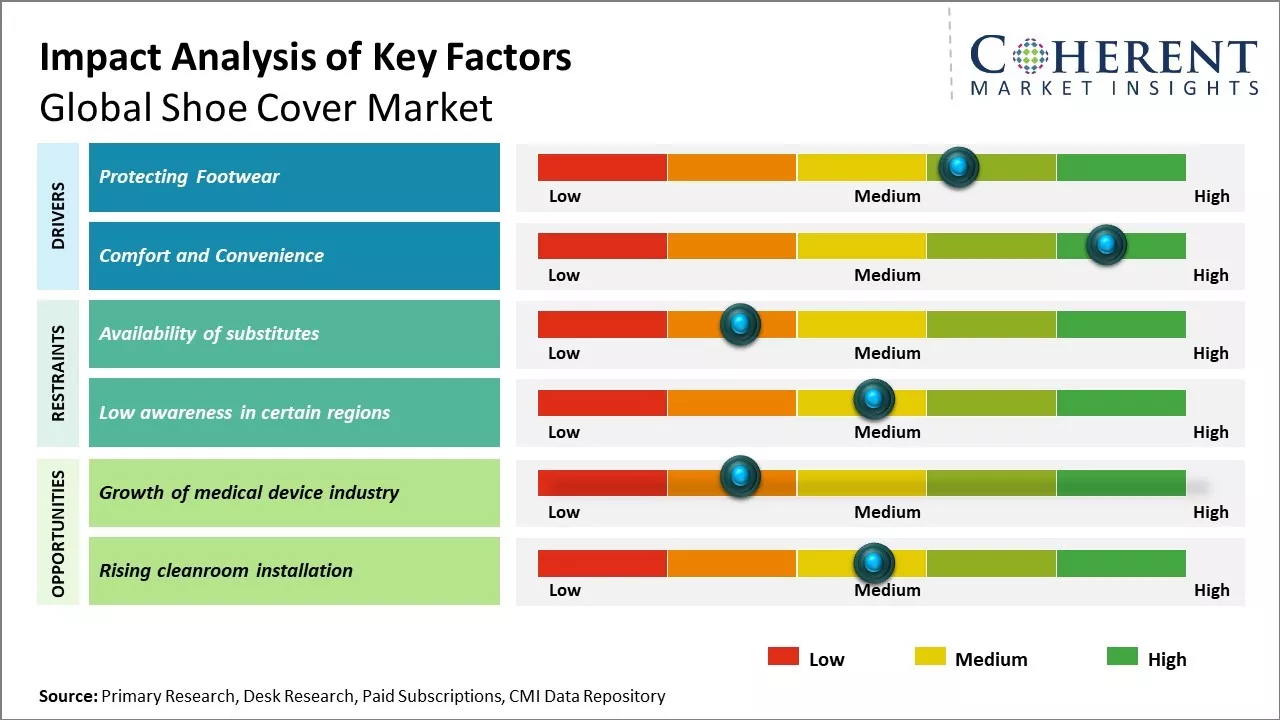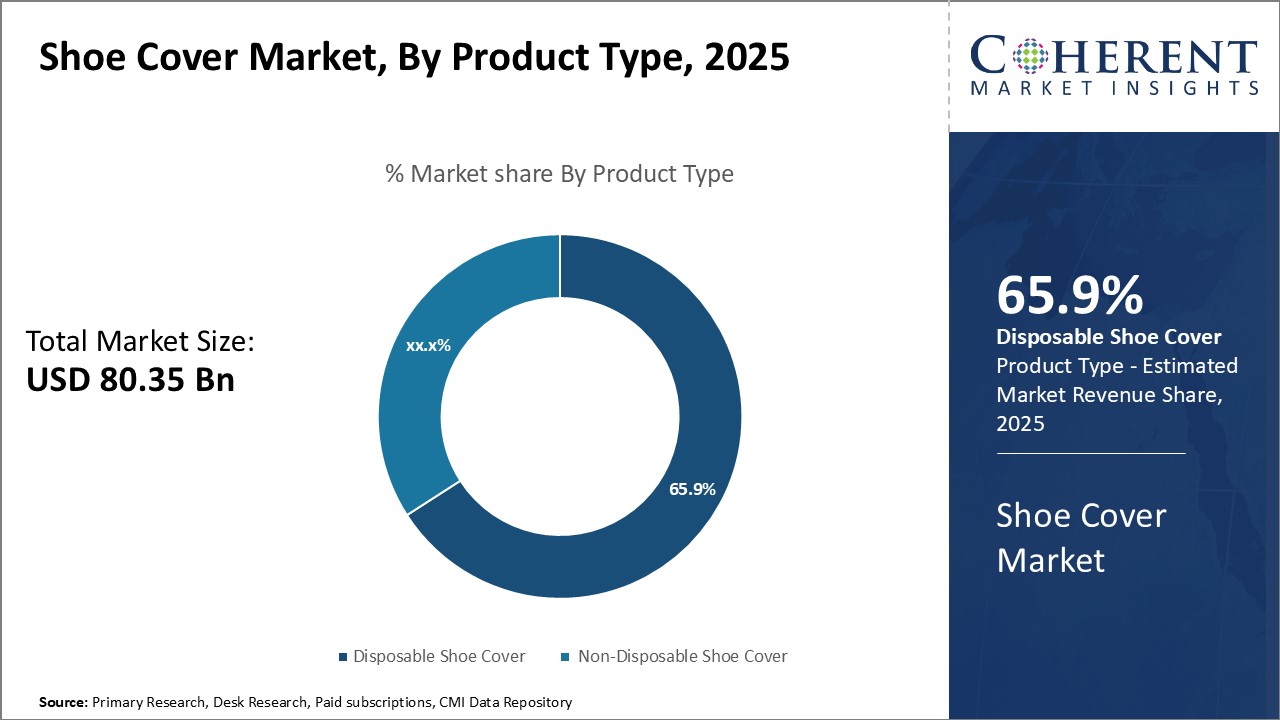Shoe Cover Market Size and Trends
Global shoe cover market is estimated to be valued at USD 80.35 Bn in 2025 and is expected to reach USD 132.53 Bn by 2032, exhibiting a compound annual growth rate (CAGR) of 7.4% from 2025 to 2032.

Discover market dynamics shaping the industry: Download Free Sample
Global shoe cover market is expected to witness positive growth over the forecast period due to growing healthcare industry and increasing awareness regarding hygiene and safety practices. Furthermore, rapid industrialization and infrastructure development in emerging economies has led to growth in construction activities, thus, boosting demand for shoe covers. Various government regulations regarding use of protective equipment in industries is expected to drive the market growth. Widespread applications of shoe cover across various end-use industries including pharmaceuticals, food processing and semiconductor manufacturing is expected to drive the market growth during the forecast period.
Protecting Footwear
Increasing usage of shoe covers helps in protecting expensive shoes and footwear from dirt, scruffs, and wear and tear. Many industries require personnel to wear dedicated shoes for safety and hygiene purposes. These shoes are often exposed to harsh environmental conditions. Using shoe covers helps to preserve the quality and durability of such shoes by providing an outer protective layer. It prevents premature wear of shoes and lengthens their usage life. This assists organizations in reducing costs associated with frequent shoe replacements. Moreover, shoe covers help maintain the presentable look of shoes used in professional settings like banking, hospitality, and healthcare. Keeping shoes clean and presentable creates a positive impression and uplifts brand image. It encourages employees and staff to prioritize foot hygiene and safety measures.
Market Concentration and Competitive Landscape

Get actionable strategies to beat competition: Download Free Sample
Comfort and Convenience
Shoe covers offer convenience and comfort for varying needs. When moving between indoor and outdoor locations, shoe covers provide a easy way to change between shoes without much effort. This is practically useful in situations like switching between gym shoes and office formals. Sectors dealing with cleanrooms and hazardous materials rely on shoe covers for safety. It allows smooth segregation of contamination risks. The easy to use and disposable nature of shoe covers add an extra layer of hygiene. Many people prefer wearing shoe covers inside homes to keep floors clean. During outdoor activities, shoe covers help wick away moisture inside wet shoes, keeping feet dry and comfortable. Growing health and wellness culture is increasing individual focus on foot hygiene. Spending more time indoors during the pandemic has amplified this awareness. Shoe covers satisfy this evolving need for simple preventive care by acting as a protective barrier for feet.
Key Takeaways of Analyst:
Global shoe cover market is expected to witness steady growth in the near future. Increasing focus of various industries like FMCG, pharmaceutical, food processing, and others on maintaining hygienic work environment can boost demand for shoe covers. Moreover, growing awareness among consumers about spread of infections through contaminated shoe soles is expected to drive the market growth.
North America dominates the global shoe cover market and is expected to retain its leading position over the forecast period. Strict adherence to quality and hygiene standards in healthcare and pharmaceutical industry makes North America a lucrative region. However, Asia Pacific is anticipated to emerge as the fastest growing market owing to rising health expenditure, rapid industrialization and strengthening regulations regarding hygienic practices.
The low durability of disposable shoe covers increases operational costs for end users. Also, open-toe or slip-on shoe styles are not compatible with shoe covers. Ongoing R&D to develop appealing shoe cover designs and durable materials could help address these challenges in the coming years.
Market Challenges: Availability of substitutes
The availability of inexpensive substitutes is significantly restraining the growth of the global shoe cover market. There are several cheap alternatives available in the market which perform similar functions as shoe covers but at a fraction of the cost. For example, plastic bags, sheets of paper or thin plastic sheets can easily be used as disposable shoe covers. While these alternatives may not offer the same degree of protection, durability and convenience as branded shoe covers, they are sufficient for basic requirements of covering shoes in many situations. This has made consumers hesitant to purchase expensive shoe covers.
Market Opportunities: Growth of medical device industry
The availability of inexpensive substitutes is significantly restraining the growth of the global shoe cover market. There are several cheap alternatives available in the market which perform similar functions as shoe covers but at a fraction of the cost. For example, plastic bags, sheets of paper or thin plastic sheets can easily be used as disposable shoe covers. While these alternatives may not offer the same degree of protection, durability and convenience as branded shoe covers, they are sufficient for basic requirements of covering shoes in many situations. This has made consumers hesitant to purchase expensive shoe covers.

Discover high revenue pocket segments and roadmap to it: Download Free Sample
Insights, By Product Type: Convenience and cost-effectiveness boosts demand for disposable shoe covers
In terms of product type, disposable shoe cover segment is estimated to contribute the 65.9% share of the market in 2025, owing to their convenience and cost-effectiveness as compared to non-disposable options. Being single-use products that can be quickly donned and discarded, disposable shoe covers save healthcare workers, food service employees, and manufacturing personnel’s significant time otherwise spent cleaning and reusing non-disposable covers. This time-saving benefit is invaluable in busy environments with high foot traffic like hospitals, thus, allowing staff to focus on patient care. Disposable shoe covers are also more hygienic as each person uses a fresh, unsullied pair which prevents cross-contamination between areas. This is crucial in medical centers and food production facilities where cleanliness standards are stringent. The disposable nature eliminates the need for cleaning and sterilization equipment otherwise needed for reusable covers, lowering overall operational costs. From an individual user perspective, disposable covers make compliance with hygiene protocols effortless. Furthermore, disposable covers pose no risk of carrying infections between areas due to improper cleaning of reused covers. These twin advantages of convenience and hygiene have cemented disposable shoe covers as the default choice where contamination control is critical.
Insights, By Material: Polyethylene segment is dominant due to polyethylene plastic's durability and affordability
Within material segment, polyethylene (PE) plastic segment is estimated to contribute the 37.2% share of the market in 2025, owing to its key advantages over competing raw materials. Made from durable yet affordable polyethylene resin, PE plastic shoe covers exhibit strength and flexibility ideal for industrial environments. Their lightweight construction allows comfortable long-term wear without fatigue. PE plastic covers withstand repeated washing and autoclaving without degrading, retaining their form and functionality through countless cleaning cycles. This durable lifespan means lower total cost of ownership versus fragile alternative materials requiring frequent replacement. Covers made from PE can also be steam sterilized to high temperatures without warping or melting, ensuring thorough decontamination. PE plastic is also chemically inert, resisting damage from harsh detergents and disinfectants used in sterilization. This preserves the hygienic integrity of covers through rigorous cleaning procedures. Its non-porous nature prevents absorption of chemicals or microbes. PE plastic can be readily injection molded into any number of cost-effective shoe cover designs. Complex designs with elastic bands, ties or printed logos are easily manufactured from PE resins at mass scale. This affordability and design flexibility have cemented PE plastic as the dominant material, thus, driving the largest market share.
Insights, By End Use: Infection control priorities fuel hospital sector's leadership
Among end use, hospital segment is estimated to contribute the 32.7% share of shoe cover market in 2025, due to its stringent hygiene imperatives. Controlling healthcare-acquired infections (HAIs) is a top priority across hospitals worldwide, provided associated risks to patient safety and costly liability issues that can arise from germ transmission. Shoe covers form a crucial line of defense in hospitals' campaigns against HAIs. By providing a physical barrier between doctors', nurses' and visitors' outdoor shoes and sterile indoor environments, covers help block tracked-in contaminants from spreading between wards, rooms or equipment. These reduce cross-contamination risks from unhygienic flooring or soles. Furthermore, shoe covers streamline compliance with infection control protocols mandating footwear changes between sensitive areas. Considering potential costs of HAIs like extended patient stays, expensive treatments and damage to reputation from preventable infections, hospitals make footwear protection through shoe covers a priority budget item. This focus on infection control through stringent hygiene practices like shoe covers drives the hospital segment market share.
Regional Insights

Need a Different Region or Segment? Download Free Sample
North America has established itself as the dominant region in the global shoe cover market with estimated 39.2% share in 2025. The region accounts for the largest industry presence with major manufacturers based in the U.S. and Canada. Strong manufacturing capabilities coupled with technological advancements have enabled North American companies to introduce innovative materials and designs. This has helped them gain significant market share both within the region as well as globally. Furthermore, stringent regulatory standards pertaining to hygiene and safety in the healthcare and food processing industries have propelled the demand for shoe covers. The well-established pharmaceutical and medical device industries are the key end users. Growing awareness about the potential threats of cross-contamination has encouraged the adoption of shoe covers across several commercial buildings. The presence of major distribution channels has also facilitated easy access to products.
Asia Pacific is emerging as the fastest growing market for shoe covers. Rapid infrastructural growth and industrialization, mainly in countries such as China, India, and Indonesia are driving the market growth. There is a rising focus on health, hygiene, and safety standards in manufacturing facilities, pharmaceutical plants, and food processing units. This offers immense opportunities for shoe cover manufacturers. The availability of raw materials and inexpensive labor has encouraged several global companies to establish production bases in the region. Asia Pacific is also a major exporter of shoe covers worldwide. Particularly, China has firmly cemented its position as the leading exporter due to low production costs. It supplies a significant volume of products to several international markets. Other Asian countries are increasingly collaborating with major brands to cater to the surging demand. The market is also witnessing the entry of local manufacturers who offer high-quality products at competitive rates. This has intensified the competitive landscape, essentially making Asia Pacific an attractive region for future investments and expansions in the global shoe cover industry.
Market Report Scope
Shoe Cover Market Report Coverage
| Report Coverage | Details | ||
|---|---|---|---|
| Base Year: | 2024 | Market Size in 2025: | USD 80.35 Bn |
| Historical Data for: | 2020 To 2024 | Forecast Period: | 2025 To 2032 |
| Forecast Period 2025 to 2032 CAGR: | 7.4% | 2032 Value Projection: | USD 132.53 Bn |
| Geographies covered: |
|
||
| Segments covered: |
|
||
| Companies covered: |
Pro shoe covers, Plasti Surge Industries Pvt. Ltd., Cordova safety products, Royal shoe covers, AMMEX, mbl impex private limited, Nelson Jameson Inc, Pro shoe covers, Protexer Corporation, Angiplast Pvt. Ltd., Medilivescare Manufacturing Pvt. Ltd., Kwalitex Healthcare Pvt Ltd, Crystal Hygiene, Wellmien , Premium Health Care Disposables Private Limited., AdvaCare Pharma, Bellcross Industries Pvt. Ltd., Shree Gajanand Industries, Medx Healthcare, Kiyaan Corporation |
||
| Growth Drivers: |
|
||
| Restraints & Challenges: |
|
||
Uncover macros and micros vetted on 75+ parameters: Get instant access to report
Shoe Cover Industry News
- In February 2022, Ansell acquired 3M's Personal Safety Division, which includes 3M's shoe covers. This acquisition expanded Ansell's PPE portfolio for customers in the pharmaceutical, medical device, and semiconductor manufacturing industries
- In 2022, GripGrab launched new gravel-specific shoe covers
*Definition: Global shoe cover market provides disposable shoe covers used to prevent dirt, dust, debris or diseases from being tracked within facilities like hospitals, laboratories, food manufacturing plants and more. Key players offer a variety of shoe covers made from breathable materials like non-woven polypropylene or fabric to protect floors and work areas. The covers are meant to be worn upon entry and discarded upon exit from controlled areas.
Market Segmentation
- Product Type Insights (Revenue, USD Bn, 2020 - 2032)
- Disposable Shoe Cover
- Non-Disposable Shoe Cover
- Material Insights (Revenue, USD Bn, 2020 - 2032)
- Non-Woven Spunbond Polypropylene (PP) Fabric
- Polyethylene (PE) Plastic
- Cast Polyethylene (CPE)
- Others
- End Use Insights (Revenue, USD Bn, 2020 - 2032)
- Hospital
- Pharmaceutical
- Food Service
- Manufacturing
- Others
- Regional Insights (Revenue, USD Bn, 2020 - 2032)
- North America
- U.S.
- Canada
- Latin America
- Brazil
- Argentina
- Mexico
- Rest of Latin America
- Europe
- Germany
- U.K.
- Spain
- France
- Italy
- Russia
- Rest of Europe
- Asia Pacific
- China
- India
- Japan
- Australia
- South Korea
- ASEAN
- Rest of Asia Pacific
- Middle East & Africa
- GCC Countries
- Israel
- Rest of Middle East & Africa
- North America
- Key Players Insights
- Pro shoe covers
- Plasti Surge Industries Pvt. Ltd.
- Cordova safety products
- Royal shoe covers
- AMMEX
- mbl impex private limited
- Nelson Jameson Inc
- Pro shoe covers
- Protexer Corporation
- Angiplast Pvt. Ltd.
- Medilivescare Manufacturing Pvt. Ltd.
- Kwalitex Healthcare Pvt Ltd
- Crystal Hygiene
- Wellmien
- Premium Health Care Disposables Private Limited.
- AdvaCare Pharma
- Bellcross Industries Pvt. Ltd.
- Shree Gajanand Industries
- Medx Healthcare
- Kiyaan Corporation
Share
Share
About Author
Yash Doshi is a Senior Management Consultant. He has 12+ years of experience in conducting research and handling consulting projects across verticals in APAC, EMEA, and the Americas.
He brings strong acumen in helping chemical companies navigate complex challenges and identify growth opportunities. He has deep expertise across the chemicals value chain, including commodity, specialty and fine chemicals, plastics and polymers, and petrochemicals. Yash is a sought-after speaker at industry conferences and contributes to various publications on topics related commodity, specialty and fine chemicals, plastics and polymers, and petrochemicals.
Missing comfort of reading report in your local language? Find your preferred language :
Transform your Strategy with Exclusive Trending Reports :
Frequently Asked Questions
EXISTING CLIENTELE
Joining thousands of companies around the world committed to making the Excellent Business Solutions.
View All Our Clients
